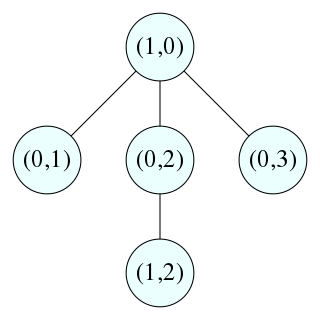 W
WCommutative algebra is the branch of algebra that studies commutative rings, their ideals, and modules over such rings. Both algebraic geometry and algebraic number theory build on commutative algebra. Prominent examples of commutative rings include polynomial rings; rings of algebraic integers, including the ordinary integers ; and p-adic integers.
 W
WIn number theory, the Chinese remainder theorem states that if one knows the remainders of the Euclidean division of an integer n by several integers, then one can determine uniquely the remainder of the division of n by the product of these integers, under the condition that the divisors are pairwise coprime.
 W
WIn ring theory, a branch of abstract algebra, a commutative ring is a ring in which the multiplication operation is commutative. The study of commutative rings is called commutative algebra. Complementarily, noncommutative algebra is the study of noncommutative rings where multiplication is not required to be commutative.
 W
WIn abstract algebra, the field of fractions of a integral domain is the smallest field in which it can be embedded.
 W
WIn ring theory, a branch of abstract algebra, an ideal of a ring is a special subset of its elements. Ideals generalize certain subsets of the integers, such as the even numbers or the multiples of 3. Addition and subtraction of even numbers preserves evenness, and multiplying an even number by any other integer results in another even number; these closure and absorption properties are the defining properties of an ideal. An ideal can be used to construct a quotient ring similarly to the way that, in group theory, a normal subgroup can be used to construct a quotient group.
 W
WIn mathematics, specifically abstract algebra, an integral domain is a nonzero commutative ring in which the product of any two nonzero elements is nonzero. Integral domains are generalizations of the ring of integers and provide a natural setting for studying divisibility. In an integral domain, every nonzero element a has the cancellation property, that is, if a ≠ 0, an equality ab = ac implies b = c.
 W
WIn mathematics, especially in the field of algebra, a polynomial ring or polynomial algebra is a ring formed from the set of polynomials in one or more indeterminates with coefficients in another ring, often a field.
 W
WIn mathematics, the tensor product of two algebras over a commutative ring R is also an R-algebra. This gives the tensor product of algebras. When the ring is a field, the most common application of such products is to describe the product of algebra representations.
 W
WIn mathematics, and more specifically in combinatorial commutative algebra, a zero-divisor graph is an undirected graph representing the zero divisors of a commutative ring. It has elements of the ring as its vertices, and pairs of elements whose product is zero as its edges.